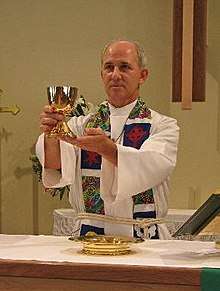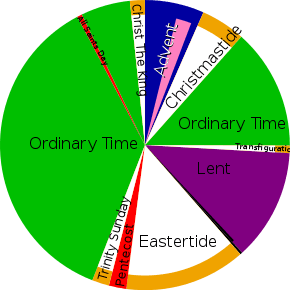Mass (liturgy)

| Part of a series on the |
| Eucharist Lord's Supper • Communion |
|---|
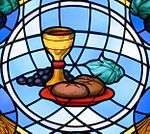 |
| Elements |
| Ritual and liturgy |
| Practices and customs |
|
| History |
| Theology |
| Denominational teachings |
| Related articles |
Mass is a term used to describe the main eucharistic liturgical service in many forms of Western Christianity. The term Mass is commonly used in the Catholic Church[1] and Anglican churches,[2] as well as some Lutheran churches,[3] Methodist,[4][5] Western Rite Orthodox and Old Catholic churches.
Some Protestants employ terms such as Divine Service or service of worship, rather than the word Mass.[6] For the celebration of the Eucharist in Eastern Christianity, including Eastern Catholic Churches, other terms such as Divine Liturgy, Holy Qurbana, and Badarak are typically used instead.
Etymology
The English noun mass is derived from Middle Latin missa. The Latin word was adopted in Old English as mæsse (via a Vulgar Latin form *messa), and was sometimes glossed as sendnes (i.e. "a sending, dismission").[7] The Latin term missa itself was in use by the 6th century.[8] It is most likely derived from the concluding formula Ite, missa est ("Go; the dismissal is made"); missa here is a Late Latin substantive corresponding to classical missio.
Historically, however, there have been other explanations of the noun missa, i.e. as not derived from the formula ite, missa est. Fortescue (1910) cites older, "fanciful" etymological explanations, notably a latinization of Hebrew matzâh (מַצָּה) "unleavened bread; oblation", a derivation favoured in the 16th century by Reuchlin and Luther, or Greek μύησις "initiation", or even Germanic mese "assembly".[9] The French historian Du Cange in 1678 reported "various opinions on the origin" of the noun missa "mass", including the derivation from Hebrew matzah (Missah, id est, oblatio), here attributed to Caesar Baronius. The Hebrew derivation is learned speculation from 16th-century philology; medieval authorities did derive the noun missa from the verb mittere, but not in connection with the formula ite, missa est.[10] Thus, De divinis officiis (9th century[11]) explains the word as a mittendo, quod nos mittat ad Deo ("from 'sending', that which sends us towards God"),[12] while Rupert of Deutz (early 12th century) derives it from a "dismissal" of the "enmities which had been between God and men" (inimicitiarum quæ erant inter Deum et homines).[13]
Mass in the Catholic Church
The Catholic Church sees the Mass or Eucharist as "the source and summit of the Christian life", to which the other sacraments are oriented.[14] The Catholic Church believes that the Mass is exactly the same sacrifice that Jesus Christ offered on the Cross at Calvary.
The ordered celebrant (main priest or bishop) is told to be in persona Christi, as he imitates the words and gestures of Jesus Christ at the Last Supper. By virtue of the mediation of the Holy Spirit, which is said to be present in the apostolic church, and through the words proferred by the celebrant, which is similar to the Word of God the Son, there takes place a transubstantiation of:
- the wine into Holy Blood, and
- the sacramental bread into the Holy Body of Jesus Christ God.
Hence, Roman Catholic and Orthodox believe that the Holy Trinity One God is really in the host, celebrated during the Saint Mass and in the previous context of the Christian consecrations (celebrant, altar, objects). The Saint Mass renews, makes alive at any time the innocent sacrifice of Jesus Christ God, as He is "the Saint of God"[15], and thus the unique door of salvation for the human sins.
The term "Mass" is generally used only in the Latin Church, while the Byzantine Rite Eastern Catholic Churches use the analogous term "Divine Liturgy" and other Eastern Catholic Churches have terms such as Holy Qurbana. Although similar in outward appearance to the Anglican Mass or Lutheran Mass,[16][17] the Catholic Church distinguishes between its own Mass and theirs on the basis of what it views as the validity of the orders of their clergy, and as a result, does not ordinarily permit intercommunion between members of these Churches.[18][19] Nevertheless, in a 1993 letter to Bishop Johannes Hanselmann of the Evangelical Lutheran Church in Bavaria, Cardinal Ratzinger (later Pope Benedict XVI) affirmed that "a theology oriented to the concept of succession, such as that which holds in the Catholic and in the Orthodox church, need not in any way deny the salvation-granting presence of the Lord [Heilschaffende Gegenwart des Herrn] in a Lutheran [evangelische] Lord's Supper."[20] The Decree on Ecumenism, produced by Vatican II in 1964, records that the Catholic Church notes its understanding that when other faith groups (such as Lutherans, Anglicans, and Presbyterians) "commemorate His death and resurrection in the Lord's Supper, they profess that it signifies life in communion with Christ and look forward to His coming in glory."[19]
Within the fixed structure outlined below, which is specific to the Ordinary Form of the Roman Rite, the Scripture readings, the antiphons sung or recited during the entrance procession or communion, and certain other prayers vary each day according to the liturgical calendar. For more information regarding the structure and history of the approved Extraordinary Form of the Mass in the Roman Rite, see Mass in the Catholic Church.
Introductory rites
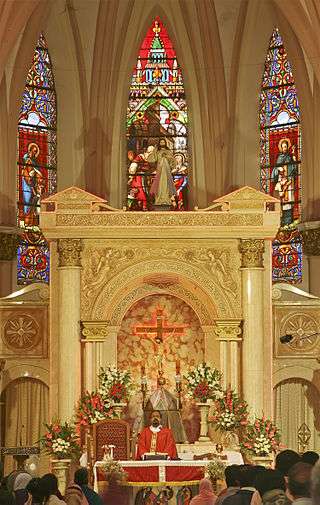
The priest enters, with a deacon, if there is one, and altar servers (who may act as crucifer, torch-bearers and thurifer). After making the sign of the cross and greeting the people liturgically, he begins the Act of Penitence. This concludes with the priest's prayer of absolution, "which, however, lacks the efficacy of the Sacrament of Penance".[21] The Kyrie, eleison (Lord, have mercy), is sung or said,[22] followed by the Gloria in excelsis Deo (Glory to God in the highest), an ancient praise, if appropriate for the liturgical season.[23] The Introductory Rites are brought to a close by the Collect Prayer.
Liturgy of the Word
On Sundays and solemnities, three Scripture readings are given. On other days there are only two. If there are three readings, the first is from the Old Testament (a term wider than "Hebrew Scriptures", since it includes the Deuterocanonical Books), or the Acts of the Apostles during Eastertide. The first reading is followed by a psalm, either sung responsorially or recited. The second reading is from the New Testament, typically from one of the Pauline epistles. A Gospel Acclamation is then sung as the Book of the Gospels is processed, sometimes with incense and candles, to the ambo. The final reading and high point of the Liturgy of the Word is the proclamation of the Gospel by the deacon or priest. At least on Sundays and Holy Days of Obligation, a homily, a sermon that draws upon some aspect of the readings or the liturgy of the day, is then given.[24] Finally, the Creed is professed on Sundays and solemnities,[25] and it is desirable that in Masses celebrated with the people the Universal Prayer or Prayer of the Faithful should usually follow.[26]
Liturgy of the Eucharist
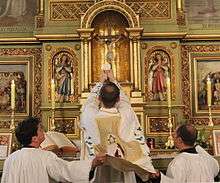
The Liturgy of the Eucharist begins with the preparation of the altar and gifts,[27] after which the congregation stands, as the priest gives the exhortation to pray, "Pray, brethren, that my sacrifice and yours may be acceptable to God, the almighty Father." The congregation responds: "May the Lord accept the sacrifice at your hands, for the praise and glory of his name, for our good, and the good of all his holy Church." The priest then pronounces the variable prayer over the gifts.
The Anaphora, also commonly called "the Eucharistic Prayer", "the centre and high point of the entire celebration",[28] then begins with a dialogue between priest and people. The oldest of the anaphoras of the Roman Rite is called the Roman Canon. The priest continues with one of many Eucharistic Prayer thanksgiving prefaces, which lead to the reciting of the Sanctus acclamation. The Eucharistic Prayer includes the epiclesis, a prayer that the gifts offered may by the power of the Holy Spirit become the body and blood of Christ.[29] The central part is the Institution Narrative and Consecration, recalling the words and actions of Jesus at his Last Supper, which he told his disciples to do in remembrance of him.[30] Immediately after the Consecration and the display to the people of the consecrated elements, the priest says: "The mystery of faith", and the people pronounce the acclamation, using one of the three prescribed formulae.[31] It concludes with a doxology, with the priest lifting up the paten with the host and the deacon (if there is one) the chalice, and the singing or recitation of the Amen by the people.
Communion rite
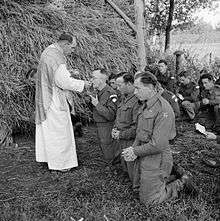
All together recite or sing the "Lord's Prayer" ("Pater Noster" or "Our Father"). The priest introduces it with a short phrase and follows it up with a prayer called the embolism and the people respond with the doxology. The sign of peace is exchanged and then the "Lamb of God" ("Agnus Dei" in Latin) litany is sung or recited, while the priest breaks the host and places a piece in the main chalice; this is known as the rite of fraction and commingling.
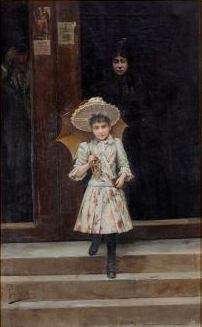
The priest then presents the transubstantiated elements to the congregation, saying: "Behold the Lamb of God, behold him who takes away the sins of the world. Blessed are those called to the supper of the Lamb." Then all repeat: "Lord, I am not worthy that you should enter under my roof, but only say the word and my soul shall be healed." The priest then receives Communion and, with the help, if necessary, of extraordinary ministers, distributes Communion to the people, who usually approach in procession and receives standing.[32] Singing by all the faithful during the Communion procession is encouraged, to highlight the communitarian nature of the Communion bread.[33] Silence is called for following the Communion procession. A Prayer After Communion is then proclaimed by the priest while all stand.
Concluding rite
The priest imparts a simple blessing or a solemn blessing to those present. The deacon or, in his absence, the priest himself then dismisses the people, choosing one of four formulas, of which the first is "Ite, missa est" in Latin or its equivalent in other languages. The congregation responds: "Thanks be to God." The priest and other ministers then leave, often to the accompaniment of a recessional hymn.
Mass in the Western Rite Orthodox Churches
As most Orthodox Christians use the Byzantine Rite, most Orthodox Churches call their Eucharistic service "the Divine Liturgy." However, there are a number of parishes within the Orthodox Church which use an edited version of the Latin Rite. Most parishes use the "Divine Liturgy of St. Tikhon" which is a revision of the Anglican Book of Common Prayer, or "the Divine Liturgy of St. Gregory" which is derived from the Tridentine form of the Roman Catholic Mass. These rubrics have been revised to reflect the doctrine and dogmas of the Orthodox Church. Therefore, the filioque clause has been removed, an epiclesis has been added, and use of leavened bread has been introduced.[34]
Divine Liturgy of St. Gregory
- The Preparation for Mass
- Confiteor
- Kyrie Eleison
- Gloria in excelsis deo
- Collect of the Day
- Epistle
- Gradual
- Alleluia
- Gospel
- Sermon
- Nicene-Constantinopolitan Creed
- Offertory
- Dialogue
- Preface
- Sanctus
- Canon
- Lord's Prayer
- Fraction
- Agnus Dei
- Prayers before Communion
- Holy Communion
- Prayer of Thanksgiving
- Dismissal
- Blessing of the Faithful
- Last Gospel
Mass in Anglicanism
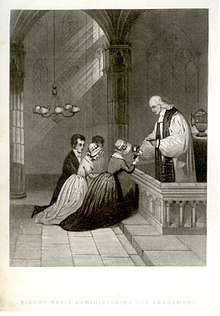
"Mass" is one of many terms used to describe the Eucharist in the Anglican tradition. More frequently, the term used is either "Holy Communion", "Holy Eucharist", or the "Lord's Supper". Occasionally the term used in Eastern churches, the "Divine Liturgy", is also used.[35] In the English-speaking Anglican world, the term used often identifies the Eucharistic theology of the person using it. "Mass" is frequently used by Anglo-Catholics.
Structure of the rite
The various Eucharistic liturgies used by national churches of the Anglican Communion have continuously evolved from the 1549 and 1552 editions of the Book of Common Prayer which both owed their form and contents chiefly to the work of Thomas Cranmer, who had rejected the medieval theology of the Mass in about 1547.[36] Although the 1549 rite retained the traditional sequence of the Mass, its underlying theology was Cranmer's and the four-day debate in the House of Lords during December 1548 makes it clear that this had already moved far beyond traditional Catholicism.[37] In the 1552 revision, this was made clear by the restructuring of the elements of the rite while retaining nearly all the language so that it became, in the words of an Anglo-Catholic liturgiologist (Arthur Couratin) "a series of communion devotions; disembarrassed of the Mass with which they were temporarily associated in 1548 and 1549".[36] Some rites, such as the 1637 Scottish rite and the 1789 rite in the United States, went back to the 1549 model.[38] From the time of the Elizabethan Settlement in 1559 the services allowed for a certain variety of theological interpretation. Today's rites generally follow the same general five-part shape[39](some or all of the following elements may be altered, transposed or absent depending on the rite, the liturgical season and use of the province or national church):
- Gathering: Beginning with a Trinitarian-based greeting or seasonal acclamation ("Blessed be God: Father, Son and Holy spirit. And Blessed be his kingdom, now and forever. Amen").[40] Then the Kyrie and a general confession and absolution follow. On Sundays outside Advent and Lent and on major festivals, the Gloria in Excelsis Deo is sung or said. The entrance rite then concludes with the collect of the day.
- Proclaiming and Hearing the Word: Usually two to three readings of Scripture, one of which is always from the Gospels, plus a psalm (or portion thereof) or canticle between the lessons. This is followed by a sermon or homily; the recitation of one of the Creeds, viz., the Apostles' or Nicene; is done on Sundays and feasts.
- The Prayers of the People: Very varied in their form.
- The Peace: The people stand and greet one another and exchange signs of God's peace in the name of the Lord. It functions as a bridge between the prayers, lessons, sermon and creeds to the communion part of the Eucharist.
- The Celebration of the Eucharist: The gifts of bread and wine are brought up, along with other gifts (such as money or food for a food bank, etc.), and an offertory prayer is recited. Following this, a Eucharistic Prayer (called "The Great Thanksgiving") is offered. This prayer consists of a dialogue (the Sursum Corda), a preface, the sanctus and benedictus, the Words of Institution, the Anamnesis, an Epiclesis a petition for salvation and a Doxology. The Lord's Prayer precedes the fraction (the breaking of the bread), followed by the Prayer of Humble Access or the Agnus Dei, and the distribution of the sacred elements (the bread and wine).
- Dismissal: There is a post-Communion prayer, which is a general prayer of thanksgiving. The service concludes with a Trinitarian blessing and the dismissal.
The liturgy is divided into two main parts: The Liturgy of the Word (Gathering, Proclaiming and Hearing the Word, Prayers of the People) and the Liturgy of the Eucharist (together with the Dismissal), but the entire liturgy itself is also properly referred to as the Holy Eucharist. The sequence of the liturgy is almost identical to the Roman Rite, except the Confession of Sin ends the Liturgy of the Word in the Anglican rites in North America, while in the Roman Rite and in Anglican rites in many jurisdictions the Confession is near the beginning of the service.
Special Masses
The Anglican tradition includes separate rites for Nuptial Masses, Funeral Masses, and votive Masses. The Eucharist is an integral part of many other sacramental services, including ordination and Confirmation.
Ceremonial
Some Anglo-Catholic parishes use Anglican versions of the Tridentine Missal, such as the English Missal, The Anglican Missal, or the American Missal, for the celebration of Mass, all of which are intended primarily for the celebration of the Eucharist. Many Anglo-Catholic parishes in the Church of England use A Manual of Anglo-Catholic Devotion (successor to the earlier A Manual of Catholic Devotion). In the Episcopal Church USA, a traditional-language, Anglo-Catholic adaptation of the 1979 Book of Common Prayer has been published (An Anglican Service Book).
All of these books contain such features as meditations for the presiding celebrant(s) during the liturgy, and other material such as the rite for the blessing of palms on Palm Sunday, propers for special feast days, and instructions for proper ceremonial order. These books are used as a more expansively Catholic context in which to celebrate the liturgical use found in the Book of Common Prayer and related liturgical books.
These are often supplemented in Anglo-Catholic parishes by books specifying ceremonial actions, such as A Priest's Handbook by Dennis G. Michno, Ceremonies of the Eucharist by Howard E. Galley, Low Mass Ceremonial by C.P.A. Burnett, and Ritual Notes by E.C.R. Lamburn. Other guides to ceremonial include the General Instruction of the Roman Missal, Ceremonies of the Modern Roman Rite (Peter Elliott), Ceremonies of the Roman Rite Described (Adrian Fortescue), and The Parson's Handbook (Percy Dearmer). In Evangelical Anglican parishes, the rubrics detailed in the Book of Common Prayer are sometimes considered normative.
Mass in Lutheranism
In the Book of Concord, Article XXIV ("Of the Mass") of the Augsburg Confession (1530) begins thus:
"Falsely are our churches accused of abolishing the Mass; for the Mass is retained among us, and celebrated with the highest reverence. We do not abolish the Mass but religiously keep and defend it... we keep the traditional liturgical form... In our churches Mass is celebrated every Sunday and on other holy days, when the sacrament is offered to those who wish for it after they have been examined and absolved (Article XXIV)".
Martin Luther rejected parts of the Roman Rite Catholic Mass, specifically the Canon of the Mass, which, as he argued, did not conform with Hebrews 7:27. That verse contrasts the Old Testament priests, who needed to make a sacrifice for sins on a regular basis, with the single priest Christ, who offers his body only once as a sacrifice. The theme is carried out also in Hebrews 9:26, 9:28, and 10:10. Luther composed as a replacement a revised Latin-language rite, Formula missae in 1523 and the vernacular Deutsche Messe in 1526.
As such, historically, the Lutheran Church has stated that the Lutheran Mass is "the only Mass founded in the Scriptures of God, in accordance with the plain and incontestable institution of the Saviour."[3][41]
Scandinavian, Finnish, and some English speaking Lutherans, use the term "Mass" for their Eucharistic service,[42] but in most German and English-speaking churches, the terms "Divine Service", "Holy Communion, or "the Holy Eucharist" are used.
The celebration of the Mass in Lutheran churches follows a similar pattern to other traditions, starting with public confession (Confiteor) by all and a Declaration of Grace said by the priest or pastor. There follow the Introit, Kyrie, Gloria, collect, the readings with an alleluia (alleluia is not said during Lent), homily (or sermon) and recitation of the Nicene Creed. The Service of the Eucharist includes the General intercessions, Preface, Sanctus and Eucharistic Prayer, elevation of the host and chalice and invitation to the Eucharist. The Agnus Dei is chanted while the clergy and assistants first commune, followed by lay communicants. Postcommunion prayers and the final blessing by the priest ends the Mass. A Catholic or Anglican of the Anglo-Catholic party would find its elements familiar, in particular the use of the sign of the cross, kneeling for prayer and the Eucharistic Prayer, bowing to the processional crucifix, kissing the altar, incense (among some), chanting, and vestments.
Lutheran churches often celebrate the Eucharist each Sunday, if not at every worship service. This aligns with Luther's preference and the Lutheran confessions.[43] Also, eucharistic ministers take the sacramental elements to the sick in hospitals and nursing homes. The practice of weekly communion is increasingly the norm again in most Lutheran parishes throughout the world. The bishops and pastors of the larger Lutheran bodies have strongly encouraged this restoration of the weekly Mass.
The celebration of the Eucharist may form a part of services for weddings, funerals, retreats, the dedication of a church building and annual synod conventions. The Mass is also an important aspect of ordinations and confirmations in Lutheran churches.
Mass in Methodism
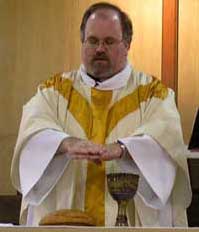
The celebration of the Mass in Methodist Churches, commonly known as the Service of the Table, is based on The Sunday Service of 1784, a revision of the liturgy of the 1662 Book of Common Prayer authorized by John Wesley.[44] The presider of a Methodist Eucharist must be an ordained or licensed minister.[45] In the Free Methodist Church, the liturgy of the Eucharist, as provided in its Book of Discipline is outlined as follows:[46]
- The Invitation:
You who truly and earnestly repent of your sins, who
live in love and peace with your neighbors and who
intend to lead a new life, following the commandments
of God and walking in His holy ways, draw near with
faith, and take this holy sacrament to your comfort;
and humbly kneeling, make your honest confession
to Almighty God.
- General Confession
- Lord's Prayer
- Affirmation of Faith
- Collect
- Sanctus
- Prayer of Humble Access
- Prayer of Consecration of the Elements
- Benediction[46]
Methodist services of worship, post-1992, reflect the ecumenical movement and liturgical Movement, particularly the Methodist Mass, largely the work of theologian Donald C. Lacy.[47]
Calendrical usage
The English suffix -mas (equivalent to modern English "mass") can label certain prominent (originally religious) feasts or seasons based on a traditional liturgical year, for example:
See also
- Black Mass
- Blue Mass
- Chantry
- Eucharistic theologies contrasted
- Gnostic Mass
- Gold Mass
- Liturgical reforms of Pope Pius XII
- Mass (music)
- Mass in the Catholic Church
- Mass of Paul VI
- Pontifical High Mass
- Red Mass
- Redemptionis Sacramentum
- Requiem Mass
- Roman Missal
- Sacraments of the Catholic Church
- White Mass
References
- ↑ John Trigilio, Kenneth Brighenti (2 March 2007). The Catholicism Answer Book. Sourcebooks, Inc.
The term "Mass", used for the weekly Sunday service in Catholic churches as well as services on Holy Days of Obligation, derives its meaning from the Latin term Missa.
- ↑ Seddon, Philip (1996). "Word and Sacrament". In Bunting, Ian. Celebrating the Anglican Way. London: Hodder & Stoughton. p. 100.
- 1 2 Joseph Augustus Seiss (1871). Ecclesia Lutherana: a brief survey of the Evangelical Lutheran Church. Lutheran Book Store.
Melancthon, the author of the Augsburg Confession, states, that he uses the words Mass and theLord's Supper as convertible terms: "The Mass, as they call it, or, with the Apostle Paul, to speak more accurately, the celebration of the Lord's Supper," &c. The Evangelical Princes, in their protest at the Diet of Spires, April 19th, 1529, say, "Our preachers and teachers have attacked and utterly confuted the popish Mass, with holy, invincible, sure Scripture, and in its place raised up again the precious, priceless SUPPER OF OUR DEAR LORD AND SAVIOUR JESUS CHRIST, which is called THE EVANGELICAL MASS. This is the only Mass founded in the Scriptures of God, in accordance with the plain and incontestable institution of the Saviour.
- ↑ Lacy, Donald Charles (1 January 1983). Methodist Mass. Fairway Press. ISBN 089536977X.
- ↑ Sterling, Jeff. "Methodist Mass at St. Paul's United Methodist Church". The United Methodist Church. Archived from the original on 2 January 2016. Retrieved 25 December 2015.
An Open Mass is a church service that features responsive readings from the liturgy, music, cantoring, a short homily, and the taking of Communion, or the Eucharist as it is sometimes called.
- ↑ Brad Harper, Paul Louis Metzger (1 March 2009). Exploring Ecclesiology. Brazos Press.
Luther also challenged the teaching that Christ is sacrificed at the celebration of the mass. It is important to pause and note that contrary to popular Protestant opinion, official Roman Catholic teaching denies that Christ is, in the mass, sacrificed time and time again. According to The Catechism of the Catholic Church, "The Eucharist is thus a sacrifice because it re-presents (makes present) the sacrifice of the cross, because it is its memorial and because it applies its fruit."
- ↑ Bosworth-Toller, s.v. "sendness" (citing Wright, Vocabularies vol. 2, 1873), "mæsse" (citing Ælfric of Eynsham).
- ↑ It is used by Caesarius of Arles (e.g. Regula ad monachos, PL 67, 1102B Omni dominica sex missas facite). Before this, it occurs singularly in a letter attributed to Saint Ambrose (d. 397), Ego mansi in munere, missam facere coepi (ep. 20.3, PL 16, 0995A ). F. Probst, Liturgie der drei ersten christlichen Jahrhunderte, 1870, 5f.). "the fragment in Pseudo-Ambrose, 'De sacramentis' (about 400. Cf. P.L., XVI, 443), and the letter of Pope Innocent I (401-17) to Decentius of Eugubium (P.L., XX, 553). In these documents we see that the Roman Liturgy is said in Latin and has already become in essence the rite we still use." (Fortescue 1910).
- ↑ The Germanic word is likely itself an early loan of Latin mensa "table". "The origin and first meaning of the word, once much discussed, is not really doubtful. We may dismiss at once such fanciful explanations as that missa is the Hebrew missah ("oblation" — so Reuchlin and Luther), or the Greek myesis ("initiation"), or the German Mess ("assembly", "market"). Nor is it the participle feminine of mittere, with a noun understood ("oblatio missa ad Deum", "congregatio missa", i.e., dimissa — so Diez, "Etymol. Wörterbuch der roman. Sprachen", 212, and others). Fortescue, A. (1910). Liturgy of the Mass. In The Catholic Encyclopedia. New York: Robert Appleton Company.
- ↑ De vocabuli origine variæ sunt Scriptorum sententiæ. Hanc enim quidam, ut idem Baronius, ab Hebræo Missah, id est, oblatio, arcessunt : alii a mittendo, quod nos mittat ad Deum Du Cange, et al., Glossarium mediae et infimae latinitatis, éd. augm., Niort : L. Favre, 1883‑1887, t. 5, col. 412b, s.v. 4. missa.
- ↑ De divinis officiis, formerly attributed to Alcuin but now dated to the late 9th or early 10th century, partly based on the works of Amalarius and Remigius of Auxerre. M.-H. Jullien and F. Perelman, Clavis Scriptorum Latinorum Medii Aevii. Auctores Galliae 735-987. II: Alcuin, 1999, 133ff.; R. Sharpe, A Handlist of the Latin Writers of Great Britain and Ireland before 1540 (1997, p. 45) attributes the entire work to Remigius.
- ↑ In Migne, PL 101: Alcuinus Incertus, De divinis officiis, caput XL, De celebratione missae et eius significatione (1247A)
- ↑ this explanation is attributed by Du Cange to Gaufridus S Barbarae in Neustria (Godfrey of Saint Victor, fl. 1175), but it is found in the earlier De divinis officiis by Rupert of Deutz (Rupertus Tuitiensis), caput XXIII, De ornatu altaris vel templi: Sacrosanctum altaris ministerium idcirco, ut dictum est, missa dicitur, quia ad placationem inimicitiarum, quae erant inter Deum et homines, sola valens et idonea mittitur legatio. PL 170, 52A.
- ↑ Catechism of the Catholic Church, 1324
- ↑ compare John 6:69 KJV, Mark 1:24 KJV and Mark 6:20 KJV
- ↑ Bahr, Ann Marie B. (1 January 2009). Christianity. Infobase Publishing. p. 66. ISBN 9781438106397.
Anglicans worship with a service that may be called either Holy Eucharist or the Mass. Like the Lutheran Eucharist, it is very similar to the Catholic Mass.
- ↑ Herl, Joseph (1 July 2004). Worship Wars in Early Lutheranism. Oxford University Press. p. 35. ISBN 9780195348309.
There is evidence that the late sixteenth-century Catholic mass as held in Germany was quite similar in outward appearance to the Lutheran mass
- ↑ Dimock, Giles (2006). 101 Questions and Answers on the Eucharist. Paulist Press. p. 79. ISBN 9780809143658.
Thus Anglican Eucharist is not the same as Catholic Mass or the Divine Liturgy celebrated by Eastern Catholics or Eastern Orthodox. Therefore Catholics may not receive at an Anglican Eucharist.
- 1 2 "Unitatis Redintegratio (Decree on Ecumenism), Section 22". Vatican. Retrieved 8 March 2013.
Though the ecclesial Communities which are separated from us lack the fullness of unity with us flowing from Baptism, and though we believe they have not retained the proper reality of the eucharistic mystery in its fullness, especially because of the absence of the sacrament of Orders, nevertheless when they commemorate His death and resurrection in the Lord's Supper, they profess that it signifies life in communion with Christ and look forward to His coming in glory. Therefore the teaching concerning the Lord's Supper, the other sacraments, worship, the ministry of the Church, must be the subject of the dialogue.
- ↑ Rausch, Thomas P. (2005). Towards a Truly Catholic Church: An Ecclesiology for the Third Millennium. Liturgical Press. p. 212. ISBN 9780814651872.
- ↑ GIRM, paragraph 51
- ↑ GIRM, paragraph 52
- ↑ GIRM, paragraph 53
- ↑ GIRM, paragraph 66
- ↑ GIRM, paragraph 68
- ↑ GIRM, paragraph 69
- ↑ GIRM, paragraph 73
- ↑ GIRM, paragraph 78
- ↑ GIRM, paragraph 79c
- ↑ Luke 22:19; 1 Corinthians 11:24-25
- ↑ GIRM, paragraph 151
- ↑ GIRM, paragraph 160
- ↑ GIRM, paragraph 86
- ↑ Ordinary and Canon of the Mass According to the Rite of St. Gregory, Antiochian Orthodox Christian Archdiocese of North America
- ↑ "The Catechism (1979 Book of Common Prayer): The Holy Eucharist". Retrieved November 19, 2011.
- 1 2 MacCulloch, Diarmaid (1996). Thomas Cranmer. London: Yale UP. p. 412.
- ↑ MacCulloch, Diarmaid (1996). Thomas Cranmer. London: Yale UP. pp. 404–8 & 629.
- ↑ Neill, Stephen (1960). Anglicanism. London: Penguin. p. 152,3.
- ↑ Seddon, Philip (1996). "Word and Sacrament". In Bunting, Ian. Celebrating the Anglican Way. London: Hodder & Stoughton. p. 107,8.
- ↑ Book of Common Prayer p. 355 Holy Eucharist Rite II
- ↑ Denominational Differences –Other Denominations. Lutheran Church–Missouri Synod.
Differences remain about both the number and the nature of the sacraments. Roman Catholics speak of seven sacraments, while Lutherans tend to speak of only two (or three). More important than number is how the sacraments are understood. To take a single example, Lutherans believe that in the Sacrament of the Altar (Communion) Christ's body and blood are truly present in the bread and wine of the Lord's Supper, but they do not accept the Roman Catholic doctrine of transubstantiation, which teaches that the elements are permanently changed from the substances of bread and wine to the substances of body and blood. Transubstantiation is rejected for several reasons: It is a philosophical explanation for a work of Christ's almighty Word which we can only believe, not explain. In seeking to explain a mystery it changes the plain and simple meanings of God's Word (Scripture refers to the elements as both bread and wine and body and blood, 1 Cor 11:26-27).
- ↑ Hope, Nicholas (1995). German and Scandinavian Protestantism 1700 to 1918. Oxford University Press, Inc. p. 18. ISBN 0-19-826994-3. Retrieved November 19, 2011. ; see also Deutsche Messe
- ↑ Preus, Klemet. "Communion Every Sunday: Why?". Retrieved November 18, 2011.
- ↑ Wainwright, Geoffrey (2006). The Oxford History of Christian Worship. Oxford University Press. p. 602. ISBN 9780195138863.
- ↑ Beckwith, R.T. Methodism and the Mass. Church Society. p. 116.
- 1 2 Bishop David W. Kendall, Barbara Fox, Carolyn Martin Vernon Snyder, ed. (2008). 2007 Book of Discipline. Free Methodist Church. pp. 219–223.
- ↑ Carpenter, Marian (2013). "Donald C. Lacy Collection: 1954 - 2011" (PDF). Indiana Historical Society. Retrieved 15 April 2018.
Lacy also published fourteen books and pamphlets. His first pamphlet, Methodist Mass (1971), became a model for current United Methodist liturgical expression. Lacy’s goal was to make ecumenism a reality by blending the United Methodist Order for the Administration of the Sacrament of the Lord’s Supper or Holy Communion and “The New Order of Mass” in the Roman Catholic Church.
Bibliography
- The General Instruction of the Roman Missal (PDF). Canadian Conference of Catholic Bishops Publication Service. ISBN 978-0-88997-655-9. Retrieved November 19, 2011.
Further reading
- Baldovin,SJ, John F., (2008). Reforming the Liturgy: A Response to the Critics. The Liturgical Press.
- Bugnini, Annibale (Archbishop), (1990). The Reform of the Liturgy 1948-1975. The Liturgical Press.
- Donghi, Antonio, (2009). Words and Gestures in the Liturgy. The Liturgical Press.
- Foley, Edward. From Age to Age: How Christians Have Celebrated the Eucharist, Revised and Expanded Edition. The Liturgical Press.
- Fr. Nikolaus Gihr (1902). The Holy Sacrifice of the Mass: Dogmatically, Liturgically, and Ascetically Explained. St. Louis: Freiburg im Breisgau. OCLC 262469879. Retrieved 2011-04-20.
- Johnson, Lawrence J., (2009). Worship in the Early Church: An Anthology of Historical Sources. The Liturgical Press.
- Jungmann, Josef Andreas, (1948). Missarum Sollemnia. A genetic explanation of the Roman Mass (2 volumes). Herder, Vienna. First edition, 1948; 2nd Edition, 1949, 5th edition, Herder, Vienna-Freiburg-Basel, and Nova & Vetera, Bonn, 1962, ISBN 3-936741-13-1.
- Marini, Piero (Archbishop), (2007). A Challenging Reform: Realizing the Vision of the Liturgical Renewal. The Liturgical Press.
- Martimort, A.G. (editor). The Church At Prayer. The Liturgical Press.
- Balzaretti, C., (2000). Missa: storia di una secolare ricerca etimologica ancora aperta. Edizioni Liturgiche.
External links
| Look up mass in Wiktionary, the free dictionary. |
| Wikiquote has quotations related to: Mass (liturgy) |
| Wikimedia Commons has media related to Mass (liturgy). |
| Wikisource has the text of the 1911 Encyclopædia Britannica article Mass. |
Roman Catholic doctrine
- Catechism of the Catholic Church, 1322-1419

- Why Fast Before Communion? by Fr. William Saunders
- Catholic Apologetics of America
- Links to documents on the Mass
- Celebrate The Liturgy
Present form of the Roman rite of the Mass
- The Order of Mass
- Fr. Larry Fama's Instructional Mass
- Today's Mass readings (New American Bible version)
- The Readings of the Mass (Jerusalem Bible version)
- Mass Readings (text in official Lectionary for Ireland, Australia, Britain, New Zealand etc.)
- Forum about Liturgy
- http://mass-online.org
Tridentine form of the Roman rite of the Mass
- Latin Mass § CatholicLatinMass.org
- SanctaMissa.org: Multimedia Tutorial on the Latin Mass
- The Holy Mass: A Pictorial Guide with Text
- Text of the Tridentine Mass in Latin and English
(For links on Post-Tridentine vs. "Tridentine" controversy, see Mass of Paul VI)
Anglican Doctrine and practice
Lutheran doctrine
- Article 24 of the Augsburg Confession, regarding the Mass
- Article 23 of the Defense of the Augsburg Confession, regarding the Mass
- The Church of Sweden Service Book including the orders for High and Low Mass
